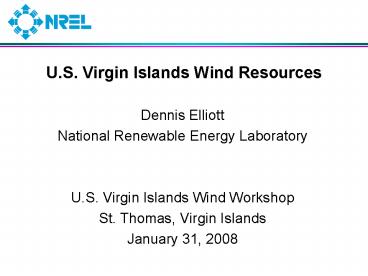U.S. Virgin Islands Wind Resources - PowerPoint PPT Presentation
1 / 25
Title:
U.S. Virgin Islands Wind Resources
Description:
U.S. Virgin Islands Wind Resources Dennis Elliott National Renewable Energy Laboratory U.S. Virgin Islands Wind Workshop St. Thomas, Virgin Islands – PowerPoint PPT presentation
Number of Views:88
Avg rating:3.0/5.0
Title: U.S. Virgin Islands Wind Resources
1
U.S. Virgin Islands Wind Resources
- Dennis Elliott
- National Renewable Energy Laboratory
- U.S. Virgin Islands Wind Workshop
- St. Thomas, Virgin Islands
- January 31, 2008
2
U.S. Virgin Islands Wind Resource Mapping
Project
Collaborative effort involving
- DOE/NREL Wind Powering America program
- U.S. Virgin Islands
- NRELs wind resource group
- AWS Truewind
3
(No Transcript)
4
High-Resolution Wind Mapping Approach
- Comprehensive modeling and validation process
produced detailed wind resource maps with a
spatial resolution of 200 m - AWS Truewind used a numerical weather model with
climatic data and wind flow model to produce the
preliminary maps - NREL and expert consultants validated preliminary
maps of 50-m annual average wind resource using - Available high-quality wind measurement data
- Knowledge of wind resources in the region and
other information - 70-m and 100-m wind maps also produced but not
validated due to lack of tall-tower data - Final wind resource maps developed based on
revision of preliminary maps from validation
results
5
Logic of Numerical Mapping Method
- Model Design and Outputs
- MesoMap - created by AWS Truewind
- A numerical weather model (MASS) coupled to a
wind flow model (WindMap) and global weather,
topographical, and land cover data - NCEP/NCAR Reanalysis (200-km grid) - most
important global weather input for MASS - MASS simulates weather conditions (including
winds) over 365 random days selected from a
15-year period - MASS runs to 2.5 km and WindMap to 0.2 km
- Model output grids provided to NREL for review
and validation
6
(No Transcript)
7
Wind Power Density vs Capacity FactorU.S. Virgin
Islands Weibull k range 2.5-3.5US Continental
(many areas) Weibull k range 1.5-2.5
8
Wind Power vs Wind Speed Maps for U.S. Virgin
Islands?
- Wind power density and equivalent wind power
class - NOT a reliable indicator of wind turbine power
output (capacity factor) in U.S. Virgin Islands - Evidence
- Wind power density in VI trade wind climate can
be 30-50 less than many continental US areas
with same mean wind speed - Wind power class on VI map can be 1 to 3 classes
lower than for many continental US areas with
same wind speed - Capacity factor for advanced wind technology NOT
significantly different at mean wind speeds of 7
m/s and greater - Therefore, wind speed maps used instead of wind
power density maps to characterize U.S. Virgin
Islands wind resources
9
Examples of Wind Power Class and Capacity Factor
- Mean wind speed 7.0 m/s but different Weibull k
- California wind corridor
- Weibull k 1.5, Power Class 5, Capacity Factor
35 - Eastern U.S.
- Weibull k 2, Power Class 4, Capacity Factor
36 - Midwest U.S.
- Weibull k 2.5, Power Class 3, Capacity Factor
36 - U.S. Virgin Islands
- Weibull k 3, Power Class 2, Capacity Factor
35 - Note Capacity factors are rounded to the nearest
whole percent
10
(No Transcript)
11
(No Transcript)
12
Wind Measurement Data for Map Validation
- Data from 4 measurement towers and 2 airports
13
Annual average shear exponents can vary from 1/7
to 0.25, causing considerable uncertainty in
vertical extrapolations of wind resource
14
- Even if 50-m wind resource is known, potential
variations in shear exponents cause considerable
uncertainty in wind resource at heights of 80-100
m - Measured shear exponent at Goodland IN is 0.235,
with much higher wind resource at 90 m than
estimated by 1/7 shear estimate
15
- High wind shear locations can have considerably
higher capacity factors at 80-100 m than low
shear locations, given similar capacity factors
at 50 m - Goodlands capacity factor of 42.5 at 90 m is
considerably higher than would be estimated by
using typical shears of 1/7 to 0.2
16
(No Transcript)
17
- Trade Winds in U.S. Virgin Islands
- Maximum annual average wind speeds 800-1000m
elevation - Seasonal variations in strength and depth of
trade winds - Peak winds June-Aug and Dec-Feb
- Terrain and roughness can cause considerable
variation in the local wind resource
18
(No Transcript)
19
(No Transcript)
20
(No Transcript)
21
(No Transcript)
22
(No Transcript)
23
(No Transcript)
24
Summary of Wind Resourcesin the U.S. Virgin
Islands
- Good wind resource areas can be found on many
exposed ridge crests and coastal areas - Maximum wind resource is generally Jun-Aug and
Dec-Feb but can vary somewhat from year-to-year - Diurnal wind climate varies considerably
throughout VI - No significant diurnal variations on exposed
eastern capes and ridge crests - Slightly greater night time winds on highest
ridge crests - Daytime max winds most other areas
- Tall-tower measurements (up to 80-100m) and
remote sensing (sodar/lidar) needed to - Estimate the wind shear at elevated heights of
50-100m - Characterize wind resource at hub-heights of
advanced wind turbines
25
(No Transcript)

